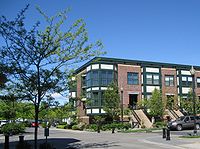- Orenco Station
-
Orenco Station Neighborhood Name origin: Orenco Country United States State Oregon Region Washington County District Hillsboro Coordinates 45°31′50″N 122°55′00″W / 45.53056°N 122.9166667°W Timezone Pacific Postal code 97124 Orenco Station is a neighborhood of the city of Hillsboro, Oregon, United States. The planned urban town center was designed as a pedestrian friendly, high density community built in conjunction with TriMet’s Westside light rail. This award winning development for urban planning was built on land formerly occupied by the Oregon Nursery Company that had built Orenco as a company town around the turn of the twentieth century. However, during the Great Depression the company went out of business, and much of the nursery land became vacant until re-development into Orenco Station beginning in 1997. Orenco Station is situated near the intersection of NW 231st/NW 229th streets and Cornell Road centered on the Orenco Station MAX stop.
Contents
History
The town of Orenco was named after the company, with OREgon Nursery COmpany becoming ORENCO.[1] After the company closed, the town eventually unincorporated in 1938.[2] In 1993, construction on TriMet’s extension to its MAX Light Rail began and planning for new high density neighborhoods along the line continued, including plans for Orenco Station.[3] The area near the old town of Orenco was labeled a “Town Center” by Metro in its 2040 plan for the region.[4]
Features
Orenco Station was developed on 209 acres (0.85 km2) in the east-central area of Hillsboro.[4] The master developer, PacTrust, along with its residential partner Costa Pacific Homes, designed a community that would mimic older neighborhoods and be more pedestrian friendly than traditional suburban neighborhoods to encourage the use of public transit.[4] Developers also worked with the city to change the zoning ordinances to allow for narrower streets, side-yard easements, garages accessed through alleys, and measures to allow live-work homes among other changes.[4] The development was a mixed-used neighborhood combining both retail and residential along the light rail line and in the middle of high-tech employers.[4] Residential options include apartments, single family dwellings, condominiums, and town homes.[4] Orenco Station also contains a large park named Central Park located just north of the retail core, along with smaller parks spread throughout the development as a trade-off for smaller yards created by the smaller lot sizes in the development. Homes in the development are situated closer to the street than in traditional developments, and all were built with Category 5 cable installed in the dwellings.[4]
During late spring through summer Orenco Station is host to the Hillsboro Sunday Farmers' Market at Orenco Station. The farmers’ market includes produce, crafts, and music.[5]
Significance
Orenco Station has been closely studied nationally and internationally as a case study of transit-oriented and New Urbanist development in a suburban context. Bruce Podobnik, a sociologist at Lewis and Clark College, completed a study in 2002 that showed comparatively high levels of resident satisfaction and "social capital", or interaction between neighbors. Transit use was also relatively high in the study—22% for commuting, versus about 6% in the region overall. Use of other modes of transportation such as walking and bicycle were also relatively high.[6] In part because of these successes, op-ed writer Alan Ehrenhalt wrote in the New York Times that Orenco Station was "perhaps the most interesting experiment in New Urbanist planning anywhere in the country" (July 19, 2000).
The development has won awards such as “Best New Burb” by Sunset Magazine in 2005.[7] Other awards include the Oregon Governor's Livability Award in 1998, the Best Masterplanned Community in America Award by the National Association of Home Builders in 1998, the Ahwahnee Award in 1999, and Transit Communities Livable Design Award awarded by AIA/ULI/FTA/STPP in 1999.[4]
References
- ^ History of Oregon Names. Webtrail. Retrieved on March 2, 2008.
- ^ Hanberg, Lou. Orenco Heritage Series: Book One. 1992.
- ^ Westside MAX Blue Line Project History. TriMet. Retrieved on March 2, 2008.
- ^ a b c d e f g h Mehaffy, Michael. Orenco Station in Hillsboro, Oregon: UnSprawl Case Study. Terrain.org. Retrieved on March 2, 2008.
- ^ About the Hillsboro Sunday Farmers' Market. Hillsboro Farmers Market. Retrieved on March 2, 2008.
- ^ [1] Podobnik (2002), The Social and Environmental Achievements of New Urbanism - Evidence from Orenco Station. Retrieved on March 10, 2008.
- ^ Levin, Rachel. Best new burb: Orenco Station. Sunset Magazine. Retrieved on March 2, 2008.
External links
- Natural Resources Defense Council: Orenco Station
- TrendWest: Orenco Station
- New Urban News: Orenco Station residents like the higher-density life
- Planetizen: Making TODs Work - Lessons from Portland's Orenco Station
- Research Study: The Social and Environmental Achievements of New Urbanism - Evidence from Orenco Station
Municipalities and communities of Washington County, Oregon County seat: Hillsboro Cities Banks | Beaverton | Cornelius | Durham | Forest Grove | Gaston | Hillsboro | King City | Lake Oswego‡ | North Plains | Portland‡ | Rivergrove‡ | Sherwood | Tigard | Tualatin‡ | Wilsonville‡
CDPs Aloha | Bethany | Bull Mountain | Cedar Hills | Cedar Mill | Garden Home-Whitford | Metzger | Oak Hills | Raleigh Hills | Rockcreek | West Haven-Sylvan | West Slope
Unincorporated
communitiesBlooming | Bonny Slope | Buxton | Carnation | Cherry Grove | Dilley | Farmington | Gales Creek | Glenwood | Hayward | Helvetia | Kansas City | Kinton | Laurel | Laurelwood | Manning | Marlene Village | Middleton | Midway | Mountaindale | Mulloy | Norwood | Roy | Scholls | Timber | Tonquin | Verboort | West Union | Wilkesboro
Ghost towns Dixie | Greenville | Thatcher
Footnotes ‡This populated place also has portions in an adjacent county or counties
Categories:- Neighborhoods in Oregon
- Hillsboro, Oregon
- New Urbanism communities
Wikimedia Foundation. 2010.




